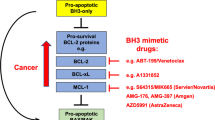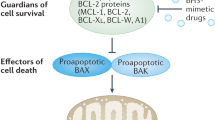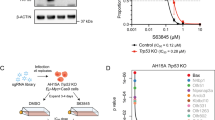Abstract
Studies of the cell death pathway in the nematode Caenorhabditis elegans provided the first evidence of the evolutionary conservation of apoptosis signalling. Here we show that the worm Bcl-2 homology domain-3 (BH3)-only protein EGL-1 binds mammalian pro-survival proteins very poorly, but can be converted into a high-affinity ligand for Bcl-2 and Bcl-xL by subtle mutation of the cysteine residue at position 62 within the BH3 domain. A 100-fold increase in affinity was observed following a single atom change (cysteine to serine substitution), and a further 10-fold increase by replacement with glycine. The low affinity of wild-type EGL-1 for mammalian pro-survival proteins and its poor expression correlates with its weak killing activity in mammalian cells whereas the high-affinity C62G mutant is a very potent killer of cells lacking Mcl-1. Cell killing by the C62S mutant with intermediate affinity only occurs when this EGL-1 BH3 domain is placed in a more stable context, namely that of BimS, which allows higher expression, though the kinetics of cell death now vary depending on whether Mcl-1 is neutralized by Noxa or genetically deleted. These results demonstrate how levels of BH3-only proteins, target affinity and the spectrum of neutralization of pro-survival proteins all contribute to killing activity.
Similar content being viewed by others
Log in or create a free account to read this content
Gain free access to this article, as well as selected content from this journal and more on nature.com
or
Abbreviations
- Bcl-2:
-
B-cell lymphoma-2
- BH3:
-
Bcl-2 homology domain-3
- ITC:
-
isothermal titration microcalorimetry
- MEF:
-
mouse embryonic fibroblast
References
Horvitz HR . Genetic control of programmed cell death in the nematode Caenorhabditis elegans. Cancer Res 1999; 59 (7 Suppl): 1701s–1706s.
Hengartner MO, Horvitz HR . C. elegans cell survival gene ced-9 encodes a functional homolog of the mammalian proto-oncogene bcl-2. Cell 1994; 76: 665–676.
Zou H, Henzel WJ, Liu X, Lutschg A, Wang X . Apaf-1, a human protein homologous to C. elegans CED-4, participates in cytochrome c-dependent activation of caspase-3. Cell 1997; 90: 405–413.
Chinnaiyan AM, Chaudhary D, O'Rourke K, Koonin EV, Dixit VM . Role of CED-4 in the activation of CED-3. Nature 1997; 388: 728–729.
Conradt B, Horvitz HR . The C. elegans protein EGL-1 is required for programmed cell death and interacts with the Bcl-2-like protein CED-9. Cell 1998; 93: 519–529.
del Peso L, González VM, Núñez G . Caenorhabditis elegans EGL-1 disrupts the interaction of CED-9 with CED-4 and promotes CED-3 activation. J Biol Chem 1998; 273: 33495–33500.
del Peso L, González VM, Inohara N, Ellis RE, Núñez G . Disruption of the CED-9/CED-4 complex by EGL-1 is a critical step for programmed cell death in C. elegans. J Biol Chem 2000; 275: 27205–27211.
Spector MS, Desnoyers S, Hoeppner DJ, Hengartner MO . Interaction between the C. elegans cell-death regulators CED-9 and CED-4. Nature 1997; 385: 653–656.
Wu D, Wallen HD, Inohara N, Nuñez G . Interaction and regulation of the Caenorhabditis elegans death protease CED-3 by CED-4 and CED-9. J Biol Chem 1997; 272: 21449–21454.
Wu DY, Wallen HD, Nuñez G . Interaction and regulation of subcellular localization of CED-4 by CED-9. Science 1997; 275: 1126–1129.
Yan N, Chai J, Lee ES, Gu L, Liu Q, He J et al. Structure of the CED-4-CED-9 complex provides insights into programmed cell death in Caenorhabditis elegans. Nature 2005; 437: 831–837.
Chen F, Hersh BM, Conradt B, Zhou Z, Riemer D, Gruenbaum Y et al. Translocation of C. elegans CED-4 to nuclear membranes during programmed cell death. Science 2000; 287: 1485–1489.
Yan N, Gu L, Kokel D, Chai J, Li W, Han A et al. Structural, biochemical, and functional analyses of CED-9 recognition by the proapoptotic proteins EGL-1 and CED-4. Mol Cell 2004; 15: 999–1006.
Woo JS, Jung JS, Ha NC, Shin J, Kim KH, Lee W et al. Unique structural features of a BCL-2 family protein CED-9 and biophysical characterization of CED-9/EGL-1 interactions. Cell Death Differ 2003; 10: 1310–1319.
Yan N, Chai J, Lee ES, Gu L, Liu Q, He J et al. Structure of the CED-4-CED-9 complex provides insights into programmed cell death in Caenorhabditis elegans. Nature 2005; 437: 831–837.
Petros AM, Nettseheim DG, Wang Y, Olejniczak ET, Meadows RP, Mack J et al. Rationale for Bcl-xL/Bad peptide complex formation from structure, mutagenesis, and biophysical studies. Protein Sci 2000; 9: 2528–2534.
Liu X, Dai S, Zhu Y, Marrack P, Kappler JW . The structure of a Bcl-xL/Bim fragment complex: implications for Bim function. Immunity 2003; 19: 341–352.
Sattler M, Liang H, Nettesheim D, Meadows RP, Harlan JE, Eberstadt M et al. Structure of Bcl-xL-Bak peptide complex: recognition between regulators of apoptosis. Science 1997; 275: 983–986.
Vaux DL, Weissman IL, Kim SK . Prevention of programmed cell death in Caenorhabditis elegans by human bcl-2. Science 1992; 258: 1955–1957.
Jabbour AM, Puryer MA, Yu JY, Lithgow T, Riffkin CD, Ashley DM et al. Human Bcl-2 cannot directly inhibit the Caenorhabditis elegans Apaf-1 homologue CED-4, but can interact with EGL-1. J Cell Sci 2006; 119 (Part 12): 2572–2582.
Delivani P, Adrain C, Taylor RC, Duriez PJ, Martin SJ . Role for CED-9 and Egl-1 as regulators of mitochondrial fission and fusion dynamics. Mol Cell 2006; 21: 761–773.
Fairlie WD, Perugini MA, Kvansakul M, Chen L, Huang DC, Colman PM . CED-4 forms a 2:2 heterotetrameric complex with CED-9 until specifically displaced by EGL-1 or CED-13. Cell Death Differ 2006; 13: 426–434.
Chen L, Willis SN, Wei A, Smith BJ, Fletcher JI, Hinds MG et al. Differential targeting of prosurvival Bcl-2 proteins by their BH3-only ligands allows complementary apoptotic function. Mol Cell 2005; 17: 393–403.
Willis SN, Chen L, Dewson G, Wei A, Naik E, Fletcher JI et al. Proapoptotic Bak is sequestered by Mcl-1 and Bcl-xL, but not Bcl-2, until displaced by BH3-only proteins. Genes Dev 2005; 19: 1294–1305.
Willis SN, Fletcher JI, Kaufmann T, van Delft MF, Chen L, Czabotar PE et al. Apoptosis initiated when BH3 ligands engage multiple Bcl-2 homologs, not Bax or Bak. Science 2007; 315: 856–859.
Certo M, Del Gaizo Moore V, Nishino M, Wei G, Korsmeyer S, Armstrong SA et al. Mitochondria primed by death signals determine cellular addiction to antiapoptotic BCL-2 family members. Cancer Cell 2006; 9: 351–365.
Kim H, Rafiuddin-Shah M, Tu HC, Jeffers JR, Zambetti GP, Hsieh JJ et al. Hierarchical regulation of mitochondrion-dependent apoptosis by BCL-2 subfamilies. Nat Cell Biol 2006; 8: 1348–1358.
Kuwana T, Bouchier-Hayes L, Chipuk JE, Bonzon C, Sullivan BA, Green DR et al. BH3 domains of BH3-only proteins differentially regulate Bax-mediated mitochondrial membrane permeabilization both directly and indirectly. Mol Cell 2005; 17: 525–535.
Lee EF, Czabotar PE, van Delft MF, Michalak EM, Boyle MJ, Willis SN et al. A novel BH3 ligand that selectively targets Mcl-1 reveals that apoptosis can proceed without Mcl-1 degradation. J Cell Biol 2008; 180: 341–355.
Del Gaizo Moore V, Schlis KD, Sallan SE, Armstrong SA, Letai A . BCL-2 dependence and ABT-737 sensitivity in acute lymphoblastic leukemia. Blood 2008; 111: 2300–2309.
Danial NN, Walensky LD, Zhang CY, Choi CS, Fisher JK, Molina AJ et al. Dual role of proapoptotic BAD in insulin secretion and beta cell survival. Nat Med 2008; 14: 144–153.
Czabotar PE, Lee EF, van Delft MF, Day CL, Smith BJ, Huang DC et al. Structural insights into the degradation of Mcl-1 induced by BH3 domains. Proc Natl Acad Sci USA 2007; 104: 6217–6222.
Moriishi K, Huang DCS, Cory S, Adams JM . Bcl-2 family members do not inhibit apoptosis by binding the caspase-activator Apaf-1. Proc Natl Acad Sci USA 1999; 96: 9683–9688.
Huang DCS, O'Reilly LA, Strasser A, Cory S . The anti-apoptosis function of Bcl-2 can be genetically separated from its inhibitory effect on cell cycle entry. EMBO J 1997; 16: 4628–4638.
O'Connor L, Strasser A, O′Reilly LA, Hausmann G, Adams JM, Cory S et al. Bim: a novel member of the Bcl-2 family that promotes apoptosis. EMBO J 1998; 17: 384–395.
Van Parijs L, Refaeli Y, Abbas AK, Baltimore D . Autoimmunity as a consequence of retrovirus-mediated expression of c-FLIP in lymphocytes. Immunity 1999; 11: 763–770.
Kinsella TM, Nolan GP . Episomal vectors rapidly and stably produce high-titer recombinant retrovirus. Hum Gene Ther 1996; 7: 1405–1413.
Sadowsky JD, Fairlie WD, Hadley EB, Lee HS, Umezawa N, Nikolovska-Coleska Z et al. (alpha/beta+alpha)-peptide antagonists of BH3 domain/Bcl-x(L) recognition: toward general strategies for foldamer-based inhibition of protein-protein interactions. J Am Chem Soc 2007; 129: 139–154.
Acknowledgements
We thank H Ierino, K Knezevic and M Evangelista for technical assistance; R Anderson, S Korsmeyer, N Motoyama, C Thompson, and W Welch for reagents and A Strasser, P Bouillet, P Kelly and M van Delft for the mcl-1−/− cells. This work was supported by grants from the Australian NHMRC (Program Grant 257502), US NCI (CA80188), Leukemia and Lymphoma Society (Specialized Center of Research 7015-02), the Cancer Council of Victoria (Project 461239), fellowships and scholarships from the NHMRC (DCSH, WDF, PMC) and the Cancer Council of Victoria (PMC – Fraser Fellowship, EFL).
Author information
Authors and Affiliations
Corresponding author
Additional information
Edited by D Vaux
Rights and permissions
About this article
Cite this article
Lee, E., Chen, L., Yang, H. et al. EGL-1 BH3 mutants reveal the importance of protein levels and target affinity for cell-killing potency. Cell Death Differ 15, 1609–1618 (2008). https://doi.org/10.1038/cdd.2008.86
Received:
Revised:
Accepted:
Published:
Issue date:
DOI: https://doi.org/10.1038/cdd.2008.86
Keywords
This article is cited by
-
Structural insight into an evolutionarily ancient programmed cell death regulator – the crystal structure of marine sponge BHP2 bound to LB-Bak-2
Cell Death & Disease (2017)
-
BCL-2 family antagonists for cancer therapy
Nature Reviews Drug Discovery (2008)



